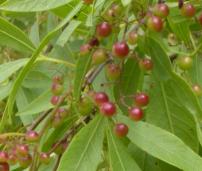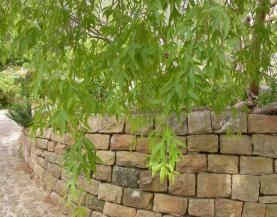Searsia pendulina
Searsia pendulina (Jacq.) Moffett
Family: Anacardiaceae
Common names: White Karee, Willow Karee, River Karee (English), Witkaree, Rivierkaree, Kareehout, Kareeboom Rosynebos, Rosyntjiebos, Wilderosyntjieboom (Afrikaans), Garas (Nama), mosilabele (South Sotho)
SA Tree No: 396
Introduction
Searsia pendulina is a perfect tree for the suburban garden, it is quick and easy to grow, tolerates wind and drought, is evergreen with a graceful habit and a neat crown, it won't get too big and it's not untidy.

Description
Description
This is a willowy evergreen small to medium-sized tree, 4 to 9 m tall, forming a neat crown of gracefully drooping branches.

The bark is pale and smooth, becoming flaky with age.

The leaves are trifoliate, narrowly lance-shaped with entire margins, and a fresh light green on both surfaces. The terminal leaflet is 25 - 95 mm x 6 - 15 mm and the lateral leaflets are slightly smaller. Being small and soft, after dropping, they curl up and disintegrate quite rapidly.

Tiny green flowers are produced in delicately branched, many-flowered panicles in spring-summer. They are inconspicuous, but attract bees and other insects. The flowers are followed by small rounded 3 mm diameter berries, green turning reddish and drying to black, usually ripening in the autumn.

Searsia lancea the karee or red karee and S. leptodictya the mountain karee are both often confused with S. pendulina . The distribution ranges of S. lancea and S. pendulina overlap in places, but S. lancea is quite easy to tell from S. pendulina, the leaflets are longer and narrower, usually much more leathery, and a darker olive-green, and the bark is dark brown to black and rough. S. leptodictya comes from the Pretoria and Witwatersrand region and while the leaflets are much the same shape size and colour as S. pendulina their margins are usually toothed, the lateral leaflets tend to be almost at right angles to the terminal one, and the bark is dark brown to black.
Distribution and habitat
Distribution description
Searsia pendulina grows in association with Salix mucronata ssp. capensis on the banks of rivers and vleis in a narrow strip that follows the Orange/Gariep River from the Free State through the Northern Cape to southern Namibia. It is a popular ornamental and is now found all over South Africa
Derivation of name and historical aspects
History
Searsia was named after Paul B. Sears (1891-1990) who was head of the Yale School of Botany and pendulina is derived from the Latin pendula meaning hanging down, in reference to the drooping nature of the branches. The name karee is rather loosely applied to several species of Searsia. It is a literal translation from the original Khoi name. The small rounded edible fruits give many species the names rosyntjiebos or - boom (raisin bush / -tree).
Most of the species grown in southern Africa, belonging to the genus Rhus, have been placed in Searsia. There are about 91 taxa of Searsia in southern Africa. Although the leaf size and shape are used to separate the species, they are also notoriously variable, making Searsia a bit of a taxonomical nightmare.
Most people have heard of the dreaded Poison Ivy or Poison Oak thanks to American films and TV programmes, but not many know that Poison Ivy, or Toxicodendron spp. also belong in the Anacardiaceae. We are fortunate that our Karee trees do not share the same chemical characteristics as their American cousins. The worst offending Searsia is S. pyroides, the fire thorn, that may cause a burning sensation if a twig pricks or scratches you. But before you get too comfortable, there is an African Poison Ivy, Smodingium argutum, a small tree or scrambling shrub, with attractive dentate trifoliate leaves and beautiful autumn colours, very similar to Searsia but with winged fruits instead of berries, whose sap causes violent skin irritations.
Ecology
Ecology
Birds eat the berries and many butterflies breed on Searsia species, the Foxtrot Copper, Samba Copper, Burnished Copper, Common Hairtail and Pearl Charaxes.
Uses
Use
The pliant slender stems of Searsia pendulina were used to build fish traps, baskets, and whips, and the stronger stems for the framework of matjieshuise (mat houses) and strong, flexible bows.
The wood has a reputation for toughness and durability and has been used for fencing poles, kerries and handles, brake blocks and for general waggon repair work, although the pieces cut are seldom long enough for planks.
The fruits of all the Searsia species are edible, rich in carbohydrate, and have formed an important part of the diet of many people, particularly those in the arid areas of southern Africa . They are eaten raw, soaked in milk, mixed with curdled milk or cooked as a kind of porridge. The fruits used to be an important ingredient of mead, in fact the name karee is thought to be derived from the original Khoi word for mead. They have also been used to brew a kind of beer. The berries are mixed with Acacia karoo gum to make a sticky sweet that tastes a bit like dates.
The bark of quite a few species is used in tanning - that of S. pendulina gives a reddish-brown colour. An infusion of leaves in milk and given as an enema to children suffering from stomach upsets.

Growing Searsia pendulina
Grow
Searsia pendulina grows fast, withstands the wind and summer drought that Cape Town gardeners have to contend with, forms a sizeable tree after only a few years, casting shade and breaking the wind. With its ease in cultivation, unagressive roots and graceful willowy crown, Searsia pendulina is a good choice for the suburban garden. Its size is also a plus in that it won't take over the neighbourhood and does not need much pruning to keep it under control. It makes an attractive, low-maintenance street tree. Searsia pendulina is an excellent choice for the water garden - it can be planted on river and stream banks, beside ponds and dams. Use it instead of the exotic willows. It is also a good 'bird tree', providing food and shelter.
Searsia pendulina is easily propagated from seed and cuttings. Water newly planted-out saplings well for their first few years to give them a good start in life - infrequent deep watering is better than frequent sprinklings.
Although from a frost-free region, Searsia pendulina should be able to survive outdoors in a Zone 9 climate (-1 to -7 ºC ). In very cold climates it can be grown in the cool glasshouse.
References
- Moffett, R.O. 2007. Name changes in the Old World Rhus and recognition of Searsia (Anacardiaceae). Bothalia 37(2):165-175
- Coates Palgrave, Keith. 2002 Trees of Southern Africa, Third edition. Struik Publishers, Cape Town.
- Palmer, E. and Pitman, N. 1972 Trees of Southern Africa . A.A. Balkema, Cape Town .
- Smith , C.A. 1966 Common Names of South African Plants. Dept. of Agricultural Technical Services, Botanical Survey Memoir No 35, Government Printer.
- Schmidt, Richard J. Anacardiaceae, http://bodd.cf.ac.uk/BotDermFolder/BotDermA/ANAC.html
- Joffe, Pitta. 2001 Creative Gardening with Indigenous Plants, A South African Guide. Briza Publications, Pretoria
- Germishuizen, G. & Meyer, N.L. (eds). 2003 Plants of southern Africa : an annotated checklist. Strelitzia 14. National Botanical Institute, Pretoria .
- Codd, L.E. 1977 Rhus viminalis: a plea for greater popularity, Veld & Flora 63(4):18-19
Credits
Alice Notten
Kirstenbosch National Botanical Garden
January 2005
Updated July 2008
Plant Attributes:
Plant Type: Tree
SA Distribution: Free State, Northern Cape
Soil type: Sandy, Loam
Flowering season: Spring, Early Summer
PH: Acid, Neutral
Flower colour: Green
Aspect: Full Sun, Morning Sun (Semi Shade), Afternoon Sun (Semi Shade)
Gardening skill: Easy
Special Features:
Horticultural zones











Rate this article
Article well written and informative
Rate this plant
Is this an interesting plant?
Login to add your Comment
Back to topNot registered yet? Click here to register.